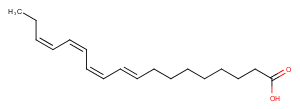cis-Parinaric Acid
| Code | Size | Price |
|---|
| TAR-T36077-1mg | 1mg | £542.00 | |||||||||||||||||||||||||||||||||||||||||||||||||||||||||||||||||||||||||||||||||||||||||||||||||
| Special offer! Add £1 to your order to get a TargetMol CCK-8 Kit. Read more here. | |||||||||||||||||||||||||||||||||||||||||||||||||||||||||||||||||||||||||||||||||||||||||||||||||||
Quantity:
Prices exclude any Taxes / VAT
Overview
Regulatory Status: RUO
Shipping:
cool pack
Storage:
-20℃
Images
Documents
Further Information
Bioactivity:
cis-Parinaric acid is a naturally occurring polyunsaturated fatty acid containing an unusual conjugated (Z,E,E,Z) tetraene. This chromophore provides for a natural fluorescence at 432 nm with an excitation wavelength at 320 nm. cis-Parinaric acid occurs naturally in the seeds of the Makita tree, a tropical rainforest tree indigenous to Fiji. Makita seeds are inedible, and this toxicity may be due at least in part to the unstable conjugated fatty acids, including cis-parinaric acid, contained within the seed. cis-Parinaric acid has been used for the measurement of phospholipase activity, lipase activity, and as an indicator of lipid peroxidation.[1][2][3][4]
CAS:
18427-44-6
Formula:
C18H28O2
Molecular Weight:
276.42
Purity:
0.98
SMILES:
CCC=C/C=CC=C/C=C/CCCCCCCC(O)=O
References
McGuire, S.O., James-Kracke, M.R., Sun, G.Y., et al. An esterification protocol for cis-parinaric acid-determined lipid peroxidation in immune cells. Lipids 32, 219-226 (1997).
Beisson, F., Fert?, N., Nari, J., et al. Use of naturally fluorescent triacylglycerols from Parinari glaberrimum to detect low lipase activities from Arabidopsis thaliana seedlings. Journal of Lipid Research 40, 2313-2321 (1999).
Wolf, C., Sagaert, L., and Bereziat, G. A sensitive assay of phospholipase using the fluorescent probe 2-parinaroyllecithin. Biochemical and Biophysical Research Communications 99, 275-283 (1981).
de Hingh, Y.C.M., Meyer, J., Fischer, J.C., et al. Direct measurement of lipid peroxidation in submitochondrial particles. Biochemistry 34, 12755-12760 (1995).



